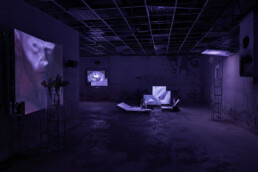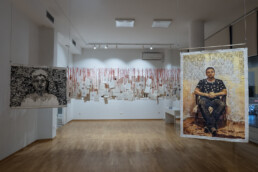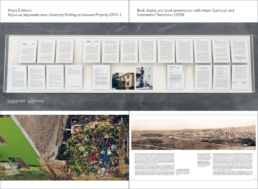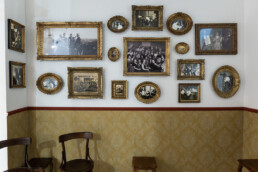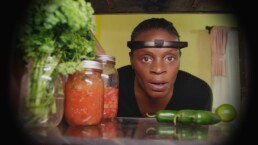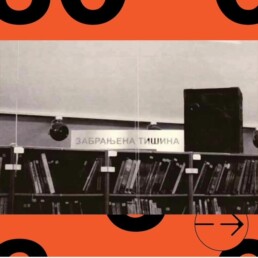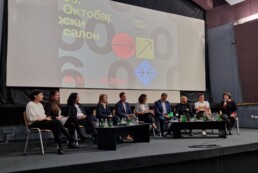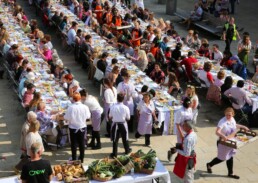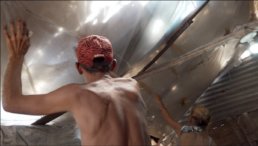Exchange program between macLYON and the Cultural Center of Belgrade and the October Salon Collection
02.12.2024., 18:00
The Cultural Centre of Belgrade
Cultural Center Belgrade invites you to attend the screening of films by Jasmina Cibic and Jesper Just, as well as a talk with the artists, which will be moderated by Matthieu Lelievre, one of the curators of the 60th October Salon and curator of the Collection of the Museum of Contemporary Art in Lyon.
The two films are co-produced by the Museum of contemporary art in Lyon and coincide with the monographic exhibitions of London-based Slovenian artist Jasmina Cibic in 2021 and Danish artist Jesper Just, who lives between New York and Berlin, in 2023, as well as to meet the artists and learn more about their artistic practices.
Jesper Just exhibited at the 60th October Salon within the concept of Aesthetics of Encounters, and Jasmina Cibic participated in the 54th October Salon and her work is in the October Salon Collection.
Every year, the Musée d’Art Contemporain de Lyon, in collaboration with the major Lyon Biennial of Contemporary Art, produces new works that are sometimes becoming new acquisitions for its collection, but the creation of a film is a very special moment that takes place sometimes over a period of several years, during which many different professions come together. These complex production projects enable many institutions, museums and production agencies to develop new forms of collaboration.
This session will provide an opportunity to discuss with artists, curators and programmers the production and curatorial process of The Gift and INTERFEARS, co-produced, presented and acquired by the Musée d’Art Contemporain de Lyon.
More about the works:
Jasmina Cibic, The Gift, 2021
Originally three channel video, 27 minutes 56 seconds
Collection of macLYON
Courtesy the artist
For Jasmina Cibic, every film project sees this artist researcher delving into the archives, the accounts recorded there as well as the silences, in order to reveal the attitudes of all forms of power – whether state, government, party political or diplomatic – towards the arts.
For the exhibition Stagecraft in 2021, Jasmina Cibic has brought together several years of research into political gifting of culture, which she unravels as the centrefold of the exhibition at macLYON in her film The Gift. This film features several emblematic buildings, including the French Communist Party Headquarters in Paris, the Palace of Nations in Geneva, the Palace of Culture and Science in Warsaw and Mount Buzludzha in Bulgaria, all of which, in their collections and architecture, constitute gifts in their own right and have a profoundly established artistic vocabulary entirely at the service of political dramaturgy.
This project by Jasmina Cibic is part of her research into the notion of soft power, which was the basis of her exhibition for the Slovenian pavilion at the 2013 Venice Biennale.
The Gift: Co-commissioned and co-produced by macLYON; FLAMIN − Film London Artists’ Moving Image Network with funding from Arts Council England and steirischer herbst ‘19; co-producers Waddington Studios London. Supported by Muzeum Sztuki in Łódź; Cooper Gallery DJCAD, University of Dundee; Northern Film School; UGM Maribor Art Gallery; United Nations, Geneva; Espace Niemeyer, Paris and Palace of Youth, Warsaw.
Jesper Just, Interfears, 2023
Film, 16 minutes
Collection of macLYON
Courtesy the artist
Jesper Just’s works are, more often than not, large, aesthetic, sculptural video installations with an enigmatic and immersive quality, in which the viewer is invited to move around. The almost surreal, ambiguous trajectories and encounters of his figures, which transcend the usual codes and stereotypes are an enthralling experience. Although his works have a cinematic quality, they diverge from film in their rhythm and the artist’s tendency to shift from narrative to total experience. In his recent productions, Jesper Just has created ecosystems that combine technology, the body and nature, using for example, electrodes connected to dancers’ bodies, aquaponic systems, and networks of tubes, cables and LED screen panels. Technology and nature converge and merge in what the artist himself calls a techno-poetics.
For his collaboration with the macLYON in 2023,, macLYON supported the production of INTERFEARS, a new film featuring the emotional topography of Matt Dillon (Outsiders, Rusty James, Singles, Sexcrimes, There’s Something About Mary, Collision, The House that Jack Built… ) captured by an MRI scanner during a soliloquy.
More about the Collection macLYON
Partner in the program: Museum of Contemporary Art in Lyon
Guided Tour in Russian ▪︎ Saturday, November 23 ▪︎ 60th October Salon
On Saturday, November 9, at 15:00, we invite you to a tour through the exhibitions of the October Salon. Together with the founder of @artmap.rs Ksenia Sedyakina you will visit the Cultural Center of Belgrade, SULUJ Gallery and the Salon of the Belgrade City Museum.
The tour will start at the entrance to the Fine Art Gallery of the Cultural Center of Belgrade at Knez Mihailova 6 and will last about two hours.
You can attend the tour free of charge and without prior registration.
———————–
Ksenija Sedyakina is an art historian based in Belgrade. She worked as a tour guide & later exhibition manager at Garage Museum of Contemporary Art in Moscow and currently is developing her own project artmap.rs.
Art as a tool to rethink the urban landscape ▪︎ Round table ▪︎ 60th October Salon
⫸ Tuesday, November, 19, 18.00, Ministry of Space, Kondina 26/2
⫸ Participants: Alessandra Saviotti (Asociación de Arte Útil), Iva Čukić (Ministry of Space), Ana Džokić (Stealth.unlimited) and Lorenzo Balbi, curator of the 60th October Salon
In today’s rapidly transforming cities, democracy and public participation face unprecedented challenges. With the increasing dominance of profit-driven capitalism, the political sphere seems paralyzed, unable to plan for a sustainable future and failing to create spaces for all citizens.
At this round table, we will examine some pressing issues such as the privatisation of public spaces, the influence of real estate on urban development, and the gentrification that often follows. Notably, we will explore how artistic practices can be a catalyst for change.
By talking about art projects in Belgrade (Ministry of Space and STEALTH.unlimited) and around the world (included in the Arte Útil archive) that envision alternative futures without prescribing fixed solutions, this event will highlight the power of creativity in reimagining cities and reclaiming spaces for public use.
The round table is part of the curatorial concept by Dobrila Denegri and Lorenzo Balbi named “Trace” within the 60th October Salon.
Building as Unowned Property, by Maria Eichhorn ▪︎ Book Promotion ▪︎ 60th October Salon
⫸ Wednesday, November 20, 18.00, Cinema Hall of the Cultural Centre of Belgrade
⫸ Book presentation and public discussion: Kτίριο ως περιουσία άνευ ιδιοκτήτη / Building as Unowned Property, by Maria Eichhorn
⫸ Speakers: Adam Szymczyk, curator and artistic director of documenta 14, Constantina Theodorou, architect and urban researcher, Lorenzo Balbi and Dobrila Denegri, curators of the 60th October Salon, and Maria Eichhorn, the author
Maria Eichhorn’s work Kτίριο ως περιουσία άνευ ιδιοκτήτη / Building as Unowned Property (2017-) was produced on the occasion of documenta 14 in Athens. It consists of purchasing real estate in Athens, on which the legal status of unowned property is conferred, to create a free site where global capitalism’s impact on the urban fabric can be rethought from an artistic and feminist-Marxist perspective. The publication records the ongoing process of purchasing the property and changing its status to unowned property since 2017. The publication, with essays by Anne Rorimer, André Rottmann, Adam Szymczyk, and Constantina Theodorou, was released in September 2024 by Verlag der Buchhandlung Walther und Franz Kõnig, Cologne and the Migros Museum fūr Gegenwartskunst, Zurich.
⫸ Numerous visitors to the 59th Biennale of Contemporary Art in Venice in 2022 remember Maria Eichhorn’s impressive work Relocating a Structure, when, by stripping the walls and foundation of the German Pavilion, she exposed the historical layers of German history and the Nazi past.
——————
Maria Eichhorn is an artist based in Berlin. Her work has been the subject of solo exhibitions at the Künstlerhaus Stuttgart (2024); Migros Museum of Contemporary Art, Zurich (2018/19); Chisenhale Gallery, London (2016); Morris and Helen Belkin Art Gallery, Vancouver (2015); Kunsthaus Bregenz (2014). In 2022, she represented Germany at the 59th Venice Biennale. In 2021 she was awarded the “Käthe Kollwitz” Award of the Academy of Arts, Berlin. Maria Eichhorn participated in documenta 14, Athens and Kassel (2017); documenta 11, Kassel (2002); and the 56th Venice Biennale (2015). Her publications include Kτίριο ως περιουσία άνευ ιδιοκτήτη (Building as Unowned Property, 2024), Relocating a Structure (2022); Hannah Arendt: Jewish Cultural Reconstruction Field Reports, Memoranda, etc. (2021); Film Lexicon of Sexual Practices / Prohibited Imports (2019); a Catalogue raisonné (2017), and 5 weeks, 25 days, 175 hours (2016). She also initiated the website www.rosevallandinstitut.org (2017).
Guided Tour in Russian ▪︎ 60th October Salon
On Saturday, November 9, at 15:00, we invite you to a tour through the exhibitions of the October Salon. Together with the founder of @artmap.rs Ksenia Sedyakina you will visit the Cultural Center of Belgrade SULUJ Gallery and the Salon of the Belgrade City Museum.
The tour will start at the entrance to the Fine Art Gallery of the Cultural Center of Belgrade at Knez Mihailova 6 and will last about 2 hours.
You can attend the tour free of charge and without prior registration.
———————–
Ksenija Sedyakina is an art historian based in Belgrade. She worked as a tour guide & later exhibition manager at Garage Museum of Contemporary Art in Moscow and currently is developing her own project artmap.rs.
OS COLLECTION + ARTANGEL ▪︎ SCREENING ▪︎ DKC ▪︎ 60th October Salon
A program of films selected through a collaboration between The Artangel Collection + MA Curating and Collections and Chelsea, UAL + 60th October Salon / October Salon Collection / Cultural Centre of Belgrade. The first part of this collaboration was realized in July in London in the form of an exhibition where the works of Francis Alÿs, Sanja Anđelković, Igor Bošnjak, Rachel Pimm & Graham Cunnington, Ben Rivers and Gregor Schneider were shown.
Second part of this collaboration will be realized through two curated selections of artist’s films that will be shown in the Cinema Hall of the Cultural Centre of Belgrade.
October Salon Collection + The Artangel Collection #2
Drenched in Salt
Artur Zmijewski, Adela Jušić and Lana Čmajčanin
Program
Cinema Hall of the Cultural Centre of Belgrade
5 pm – Curatorial statement, video, 5 min
Artur Żmijewski, Operation Cast Lead, 2009, 22min
Adela Jušić & Lana Čmajčanin, I Will Never Talk about the War Again, 2011, 9.42 min
Drenched in Salt, is a film screening programme curated by students of MA Curating & Collections (MACC), Chelsea College of Arts, University of London, The title of the programme references the poem, Drenched, written by Palestinian poet Dr. Refaat Alareer who was killed in an Israeli airstrike on the 6th of December 2023. Through this poem, Alareer describes the death and violence on Palestinian bodies and his overwhelming grief. Salt is used in many cultures and rituals as a tool to cleanse, protect and preserve, but being ‘drenched in salt’ can also sting, hurt or burn.
As the cooperation is realized within the curatorial concept “Hope is a discipline”, inspired by the statement of Mariam Keba, the program “Drenched in Salt” reminds us of what is occurring to thousands of innocent civilians, while the world watches.Following the mentioned curatorial concept, hope is used as an invitation to act, gain knowledge, awareness, clarity and build solidarity, and in this case, through an agonistic approach.
Responding to the 60th October Salon’s question of ‘What’s Left?’, MACC presents a programme of two selected films from the October Salon collection. The selected films reinforce the understanding of colonial power structures and their very real consequences. We do not aim to provide solutions, but to start reflection, conversation and action.
Drenched in Salt is curated by Nis Azmee Murat, Yining Bai, Mengze Geng, Riccardo Greco, Maria Herrero Tejada, Yaqi Liang, Wanjing Lin, Heyue Lu, Wenyan Ma, Charmaine Wah, Xingcheng Xu, and Lilian Zancajo-Lugo.
Trigger warnings: Explicit scenes of blood, violence and death, including but not limited to severed limbs, corpses and severely injured children.
More about the works and artists
Artur Żmijewski, Operation Cast Lead, 2009, film, 22’
Courtesy of the Cultural Centre of Belgrade, October Salon Collection, the artist
The film tells the story of the brutality and senselessness of the Israeli military attacks carried out in Gaza in 2009.It is a montaged video material recorded by activists of the B’Tselem Group –Israeli Centre for Human Rights in the Occupied Territories, as well as by Gaza residents themselves. Originally, the work was accompanied by 16 drawings made during Artur Żmijewski’s talks with residents of Holon and Tel Aviv, on what was happening in Gaza. The artist asked these people to draw what they were talking about so this edition of the work is titled My Neighbours and fully reflects the mental condition of Israeli citizens at this specific moment in history.
Artur Žmijevski (1966, Warsaw. Poland) https://kadist.org/people/arthur-zmijewski/
Adela Jušić, Lana Čmajčanin, I Will Never Talk about the War Again, 2011, 9.42 min
Courtesy of the Cultural Centre of Belgrade, October Salon Collection, the artists
Lana Čmajčanin’s and Adela Jušić’s video performance draws attention to the post-war situation, in which the past war in the former Yugoslavia is a recurring theme. Personal experience shows that it is impossible not to talk about the war in everyday life. In this performance, two artists try to express a full range of emotions related to the war, but also to point to different positions in talking about the war; the way how nationalist political parties constantly refer to the war in the media – in order to maintain power and intolerance between the peoples of the former Yugoslavia on national grounds.
Adela Jušić (1982, Sarajevo, Bosnia and Herzegovina). adelajusic.wordpress.com/
Lana Čmajčanin (1983, Sarajevo, Bosnia and Herzegovina) https://www.lanacmajcanin.com/
————————
October Salon Collection + The Artangel Collection #3
Mika Rottenberg, Abi Palmer, Andy Holden and Peter Holden
Program
Cinema Hall of the Cultural Centre of Belgrade
6 pm
Mika Rottenberg, Mahyad Tousi. Remote, 2022, 92min
8 pm Abi Palmer Invents the Weather: Rain, 2023, 12 min
Andy Holden and Peter Holden, A Natural History of Nest Building, 2017, 31min
Selection of films from The Artangel Collection curated by Persila Katon, Lina Džuverović and Zorana Đaković Minniti.
The Artangel collection was launched in partnership with Tate in 2011 to enable notable film and video installations to be presented across the UK. Over 25 moving image works – commissioned by Artangel since 1993 – are available for loan, free of charge, to publicly-funded UK museums and galleries.
REMOTE, Abi Palmer Invents the Weather and A Natural History of Nest Building are part of The Artangel Collection, an initiative to bring outstanding film and video works, commissioned and produced by Artangel, to galleries and museums across the UK. The Artangel Collection has been developed in partnership with Tate, is generously supported by the Esmée Fairbairn Foundation and The Foyle Foundation and uses public funding from Arts Council England.
Note: all films are with English subtitles
More about the works and artists
Mika Rottenberg, Mahyad Tousi. Remote, 2022, 92min
In their extraordinary first feature film, Mika Rottenberg and Mahyad Tousi create a strangely credible solar-punk world. Set in a near future, REMOTE follows Unoaku, an expat architect living in a solar-punk apartment in Kuala Lumpur, and four other women living on their own in Iran, Argentine, Puerto Rico and South Africa. While watching a popular South Korean dog grooming show, the five women discover they are connected through mysterious portals hidden in their homes.
Filmed in 2021 during the COVID pandemic with a cast of multinational actors and performers including Okwui Okpokwasili and Joony Kim, REMOTE explores what it means to live in a ‘hyperconnected’ future populated by isolated individuals who find new ways to maintain human relationships.
Commissioned by Artangel; the Louisiana Museum of Modern Art, Humlebaek, Denmark; and Moderna Museet, Stockholm, Sweden; in association with Hauser & Wirth. The film was completed with support by MOCA’s Environmental Council, Los Angeles, US; Musée d’art contemporain de Montréal, Canada; X Museum, Beijing, China; the Busan Biennale, Korea; and The Contemporary Jewish Museum, San Francisco, US.
Abi Palmer: Abi Palmer Invents the Weather: Rain, 2023, 12 min
Abi Palmer Invents the Weather is a series of four short films by artist and writer Abi Palmer made collaboratively with her two cats, Cha-U-Kao and Lola Lola. Unable to reach the outside world during the Covid-19 pandemic, Palmer began a year-long process of performing the outside world for her indoor cats, translating each season into a cat-accessible format. The accompanying voiceover, written and narrated by Palmer, is a love letter to her cats and the climate, and explores the tensions between what we can and can’t control. The resulting films are a playful meditation on disability, climate, and life that can’t talk back.
Rain is the first film from the series of four, and it takes on a literal interpretation of the autumn season. Palmer goes through a lengthy process of trying to recreate petrichor, the earthy smell which happens when it rains.
Commissioned and produced by Artangel for The World Weather Network, a constellation of weather stations set up by 28 arts agencies around the world, formed in response to the climate emergency. Supported by Artangel’s Guardian Angels.
Andy Holden and Peter Holden: A Natural History of Nest Building, 2017, 31 min
A Natural History of Nest Building is a three-screen video installation in which father and son talk about different types of birds’ nests, nest sites and materials. Whilst they find common ground in their shared wonder at the ingenuity and skill of a wide variety of birds, from the chaffinch and the crow to tailorbirds and weavers, they sometimes diverge in what intrigues them most.
Peter’s approach is firmly grounded in Darwin’s theory of evolution and ‘natural selection’ (the title Darwin initially gave to the book eventually published as On the Origin of Species by Means of Natural Selection) whereas Andy is absorbed by the idea that nest building is a considered, creative act. As they look at the extraordinary diversity of nests that birds build, their conversation touches on instinct and learning, the importance of creative collaboration and the nature of parental influence.
Commissioned by Artangel, Bristol Museum and Art Gallery, Leeds Art Gallery and Towner Art Gallery, with the support of the National Lottery through Arts Council England, Spike Island and Bristol Green Capital 2015, the Henry Moore Foundation and Artangel’s Guardian Angels.
DREAM CLUB ▪︎ Radio-station and Club ▪︎ Ex Club Akademija
⪢ A radio project for @oktobarski_salon for 6 weeks broadcasting from historical Klub Akademija, a stronghold for Belgrade’s underground culture along the 80’/90’s/2000’s
⪢ Contributions, radioshows, live performances and talks will be aired in streaming and via FM, and everyday from 1pm to 6pm public can access the club as a listening space or to assist live to concerts and shows.
⪢ We’ll have any sort of guests from musicians and journalists from that time to organizers and performers active now internationally, students, artists and more!
⪢ Follow program and contributors and tune in at www.spettro.info/dreamklub or at 98.2Mhz if in town!
Oct 19 – Dream Klub Project launch: live show w/ Bane Jovancevic and Francesco Fonassi from 5PM to 8PM.
Oct 20 – Live showcase w/ Estades (ES), Vacas (ES), Poseidonia (IT) and Devid Ciampalini (IT) from 1PM to 6PM
Oct 21 – Akademija Legacy Revisited, radioshow and conversation moderated by Toma Grujic w/ Uros Djuric, Dobrila Denegri and Biljana Tomic about Klub Akademija history and Miomir Grujić Fleka’s Radio Šišmiš, 2pm to 6pm.
Oct 22 – Dream Klub One-Day Radio Festival w/ Incompetence Records.Curated by Inturist (RUS) from 1PM to 6PM (artists TBA).
Oct 23 – Dream Klub One-Day Radio Festival. Curated by Bane Jovancevic from 1PM to 6 PM (artists TBA).
Oct 24 – Live showcase w/ Canedicoda (IT), Massimo Carozzi (IT), Laura Angeles (ES), Spettro Crew (IT), KNN (IT), from 1PM to 6PM.+Meeting from the Klub with the Fine Arts Academy professors Nemanja Nikolic and Lidija Delic’s students.
Oct 25 – Dream Klub Archive: Rex Ilusivii (Mitar Subotić – SUBA) special show from 1PM to 6PM.
+Loophole Magazine: focus and live conversations w/ selected Octobber Salon artists
+ Every day music selections, tape and electronics impros and intermezzo live from the Klub by Francesco Fonassi and Flavia Spasari
SELECTION FROM THE PROGRAM OF THE 60TH OCTOBER SALON
All exhibition spaces of the 60th October Salon open on Sunday, October 20, at 1 p.m., and during the six weeks of the event, the public can expect numerous exhibitions and programs in which more than forty domestic and foreign artists participate.
During the more than one month duration of the 60th October Salon, from October 20 to December 1, at nine locations and in public spaces in the city, numerous programs will take place in various formats: readings, talks, discussions, workshops, performances and lectures.
As announced at the press conference held on Friday, October 18, in the Cultural Center of Belgrade, the entrance to all exhibitions and programs is free, and this year's locations are: three galleries of the Cultural Center of Belgrade (Art Gallery, Artget Gallery and Podroom Gallery), Pavilion in Cvetni trg, FLU Gallery, former Akademija Club, ULUS Gallery, SULUJ Gallery, Salon of the City of Belgrade Museum, the Museum of African Art, the windows of the French Institute and public spaces in the city.
The performance 7x70 – Meal by authors Lucy and Jorge Orta was organized before the official opening of the event, on Friday, October 18, in front of the Cultural Center of Belgrade. Lunch in a public space for 200 guests, in the public space, brought together some of the figures on the public, political and cultural scene of Belgrade, with the idea that "sitting at the same table, sharing bread and food" can be a way of drawing attention to some of the burning issues faced by artists and cultural workers in our country. This work is a part of the curatorial concept Trace, which through sends a message about the necessity of providing spaces where artists can create, and which are important for the stimulation and development of the artistic and cultural scene. In addition to this concept, the October Salon consists of two more parallel lines: Aesthetic(s) of Encounter(s) examines what results from the exchange of foreign and domestic authors, sharing and association, while the concept Hope is a discipline focuses on our experience of work, on the
uselessness of work and on the connection between work and art .
The puppet show by Daniela Ortiz, an artist from Peru, which will be presented for the first time in front of the Cvijeta Zuzorić Pavilion on the opening day, Sunday, October 20, tells in an allegorical way about the necessity of the fight for free speech and the necessity for art to be critical of the economic, political and social imperatives of liberal capitalism.
"Where are our spaces for work?" is a question that the citizens of Belgrade have the opportunity to see on billboards during the manifestation. It is about the work of Nina Ivanović, which shows the BIGZ and Jugošped buildings, spaces whose repurposing means the departure of artists from them. On this occasion, on October 23, artists will organize a participatory performance on Cvetni trg, which will draw attention to this topic.
The members of the local collective Karavan are inspired by the memorabilia they find in the Roma settlement of Bair, where the Karavan creates murals on the walls of the family houses of musicians, with the recommendations and suggestions of Bair residents. Art duo dopelgenger's Recording of a termite landscape is an essay in which the authors look at images of the past of miners in a socialist society, comparing them to the hidden image of mining in a capitalist society.
The video work The Value of Absence by Adrian Melis talks about distrust towards Cuba's socialist economic model, where public servants invented excuses to miss work due to low wages. Melis decides to pay for these excuses by giving the people producing the video work exactly the amount of money their absence from work is worth.
Kiluanzhi Kia Henda, an artist from Luanda, will show a film about political and social problems in the contemporary art scene of Luanda in the Cultural Center of Belgrade Cinema Hall (DKC), and the artist Mwana from Angola will present the performance A ritual of sisterhood in the Museum of African Art.
Alfredo Haar, painter, artist and architect, is also a guest of Belgrade. Hewill hold a public lecture Things are falling apart at DKC.
The programme will also include several workshops for children, in the Cultural Center of Belgrade Cinema Hall and in the Museum of African Art.
⫸ Detailed program: https://oktobarskisalon.org/program/
-------------------------------------------------- -------------
7x70 - Meal, Lucy + Jorge Orta
The performance 7×70 - Meal, created by Lucy and Jorge Orta, was organised before the official opening of the 60th October Salon on Friday, October 18, at 2:00 p.m., in front of the Cultural Centre of Belgrade. Lunch for 200 guests brought together some of the figures of the public, political and cultural scene of Belgrade, with the idea that "sitting at the same table, sharing bread and food" can be a way of drawing attention to some of the main issues faced by artists and cultural workers in our country.
The lunch in Belgrade is the 47th meal that Lucy and Jorge Orta have organized in public spaces of various cities around the world.
“The Starving Bureaucrat” ▪︎ Adrian Melis and Đeji Hadrović ▪︎ Opening of the 60th October Salon
In his work, Melis addresses issues like labor conditions, inefficiency, and unproductivity from a sociopolitical and artistic perspective. In most cases, he uses his own work to create a platform for others to express, in an ironic, absurd, and humorous way, their concerns about the relationship between art and labour.
Within the “Hope is a Discipline” concept, Melis presents this work in collaboration with Slovenian artist Đejmi Hadrović, addressing what they called “a performance within a performance.” The work is based on the topic of unpaid artistic labor in the political and economic system of contemporary capitalist societies.
In “The Starving Bureaucrat” Melis’s invisible performance consists of inviting Dejmi Hadrovic, a Slovenian artist and colleague to take part with him in the festival. Following the communication with the curatorial team, they both succeeded in making the festival pay for all things any artist deserves, traveling, accommodation, artist fee and per diem, and even the possibility of presenting her work by using Melis’s place. During the performance, Melis won’t be an active part of it, instead, Đejmi will present her own personal approach to the topic of “starving artists” by addressing the relationship between artists and institutions in a capitalist society such as unpaid work, invisible and side jobs to survive the lack of opportunities.
———————————————-
Adrian Melis Sosa (Havana, Cuba, 1985) is a multidisciplinary artist, based in Cuba and Europe. Between 2005 and 2010, Melis studied at the University of Arts in Havana. He is a former resident of the Rijksakademie van Beeldende Kunsten of Amsterdam (2014/2015). He is currently teaching at Berlin Art Institute. He has exhibited in several museums and institutions including, among others, Kunsthalle Basel, Basel; Museum of Modern Art, Warsaw; Wiels, Brussels; Centre Pompidou, Paris; Pinchuk Art Center, Kyiv; Pori Art Museum, Pori; De Appel Center, Amsterdam; Queens Museum, New York, and the 10th Shanghai Biennial. Since 2010 he is represented by ADN Galería, Barcelona, where his solo exhibitions in 2012 and 2013 were awarded the “Art Nou” Award by the Association of Galleries Barcelona and the GAC award (MACBA) for Best Exhibition in a Private Gallery, respectively. In the year 2023 Melis was granted the CIFO awards for latinoamerican artists. His work is in private and public collections, including LENTOS Museum, Linz; Pori Art Museum, Finland; MAS Santander, Spain; MACBA Barcelona; Fundación Cerezales Antonino y Cinia, Spain; Collection Alain Servais, Belgium; Collection Lemaître; Collection A. de Galbert, France and Collection Teixeira de Freitas, Portugal.
